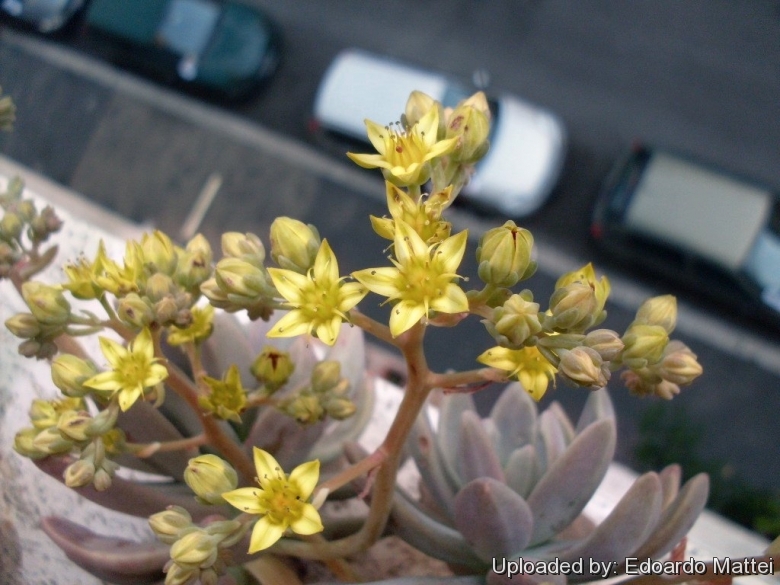




Your support is critical to our success.

Origin and Habitat: Garden origin (Nursery produced cultivar)
Synonyms:
Description: Graptosedum cv 'Francesco Baldi' is a beautiful interspecific hybrid between two different Mexican species in the Crassulaceae family: Graptopetalum paraguayenseSN|27644]]SN|27644]] and Sedum pachyphyllumSN|19403]]SN|19403]]. It inherited the pink colouration of the first and the leaf shape from the Sedum. It is a heavy bloomer, the yellow flowers are numerous and produced more readily than in many other species. As many succulents, colours change in seasons.
Habit: It is a hairless, rosette-forming, succulent plant. The rosettes grow at the tips of ever-lengthening hanging stems creating a low spreading colony to only about 15 cm tall.
Stems: 5-8 mm across.
Rosettes: 10-12 cm across, with shingled leaves forming a symmetric Fibonacci spiral. Old leaves at the base of the rosette wither and fall off. New growth is from the centre of the rosette, so over time you get a denuded stem with a rosette on the end.
Leaves: Succulent, lanceolate up to 6-7 cm long glaucous pale green. Those grown in partial shade tend to be blue-grey; in full, hot sun pinkish grey. During the winter the leaves take a brownish-purple tinge enhanced by low temperature.
Flowers: Star shaped. Petals 5 yellow, c.2 cm in diameter, borne on stems to 15 cm long with 2-6 branches, each with 3-14 flowers. Petals c. 1 cm long white, dotted with red.
Blooming season: The plant flowers profusely in late winter-early spring.
Cultivation and Propagation: Culture of Graptosedum cv 'Francesco Baldi' is fairly easy, it can tolerate full sun (where it stay compact) but a better exposure is half-sun. The plant's origin will make its rosettes tolerate heat, frost and drought. It is always a favourite carefree windowsill citizen, an excellent addition to any garden.
Exposition: Likes light shade to part sun (it will take a few hours of sun without a problem), but adapts very well to full sun and shade too. It can overwinters well also under grow lights in a cool room of the house. Graptosedums are chameleons. Those grown in partial shade tend to be blue-gray; in full, hot sun, gray-pink; in full sun, pinkish gray to yellow.
Soil: Although it needs a soil that is gritty and porous with good drainage, the soil must be able to hold the moisture that the plant requires. The ideal soil should contain equal parts of loam with small gravel added (eg pumice or lava grit). Good drainage is essential.
Watering: During the summer growing period the plant appears to need much more water than the average succulent. Water when plant is dry and do not water again until the soil is completely dry again. Dislikes over-watering. Pay particular attention to make sure that they do not rot at the root from soggy soil. During October to March, water very sparingly, using only enough water to keep the foliage from shriveling. In a very humid situation in winter, it can rot even if totally dry. It likes dry air as much as dry soil.
Fertilization: Fertilizer should be applied only once in early spring , diluted to ¼ the recommended rate on the label.
Hardiness: It is usually recommended to avoid freezing temperatures, but it is a very hardy succulent and can rebound from being frozen and is useful in areas that drop below -5° (-7°) C. It requires low temperature for flower formation and it will not flower unless it is overwintered for at least a month at 15° C or less. USDA zones 9-11.
Pests and diseases: No serious insect or disease problems. Watch for aphids and scale. Mealybugs infestations are also a frequent problem.
Human hazards: None.
Uses: A great plant for use as a groundcover, in gravel gardens, paved areas, rockeries, in hanging baskets or pots, or for spilling over walls. It is a bit brittle so avoid handling when possible and not for planting in areas with much traffic. Because the stems are so fragile, it is best to pick the best location for ghost plant and then don’t move it. Try mixing with other succulents and alpines.
Propagation: It is is propagated by the division of offshoots or by individual leaves, rooted in sand or in dry vermiculite. Any rosette that breaks off has the potential to root and start a new plant. Even a leaf that drops off will root below the parent plant and produce a new rosette quickly. Because leaves and cuttings root effortlessly, graptopetalums are among the easiest succulents to propagate.
| Your Actions | |
|---|---|
| Back to Graptosedum index | |
| Back to Crassulaceae index | |
 |
Back to Succulents Encyclopedia index |
Privacy stantement - Terms and conditions - How to cite - About us - Feedback - Donate



